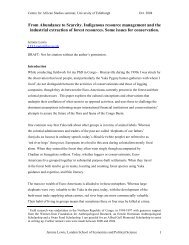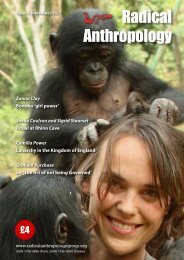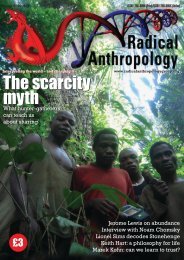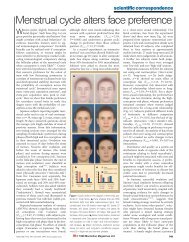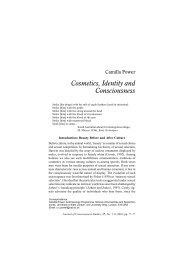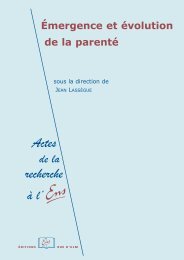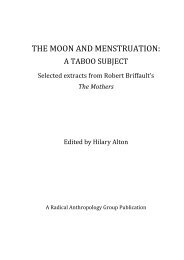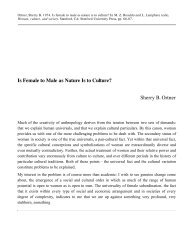Language and life history: A new perspective on the development ...
Language and life history: A new perspective on the development ...
Language and life history: A new perspective on the development ...
- No tags were found...
You also want an ePaper? Increase the reach of your titles
YUMPU automatically turns print PDFs into web optimized ePapers that Google loves.
Commentary/Locke & Bogin: <str<strong>on</strong>g>Language</str<strong>on</strong>g> <str<strong>on</strong>g>and</str<strong>on</strong>g> <str<strong>on</strong>g>life</str<strong>on</strong>g> <str<strong>on</strong>g>history</str<strong>on</strong>g>status as important factors in language origins is in itself notimplausible. But in order to explain <strong>the</strong> distinguishing featuresof language, selecti<strong>on</strong> for c<strong>on</strong>tent must be part of <strong>the</strong> scenario.The proposal of Miller (2000), discussed by L&B at <strong>the</strong> end ofsecti<strong>on</strong> 5, goes in <strong>the</strong> right directi<strong>on</strong>: “<str<strong>on</strong>g>Language</str<strong>on</strong>g> put minds <strong>on</strong>public display, where sexual choice could see <strong>the</strong>m clearly”(Miller 2000, p. 357, quoted in L&B). Related ideas are proposedby Dessalles (2000), in which status is gained through publicspeech c<strong>on</strong>taining relevant informati<strong>on</strong>, thus placing selectivepressure squarely <strong>on</strong> <strong>the</strong> ability to provide c<strong>on</strong>tent. L&B dorefer to <strong>the</strong> work of Dessalles, but by focusing too much <strong>on</strong>form ra<strong>the</strong>r than c<strong>on</strong>tent, <strong>the</strong>y leave a gaping hole in <strong>the</strong>irargumentati<strong>on</strong>.L&B do attempt to motivate <strong>the</strong> primacy of vocal abilities overgrammar in <strong>the</strong>ir scenario, by arguing that it makes more sensefor speech to evolve before syntax than vice versa. This is notself-evident, for several reas<strong>on</strong>s. First, grammar is not just“syntax” but patterned c<strong>on</strong>tent, which has been emphasized fordecades by functi<strong>on</strong>al <str<strong>on</strong>g>and</str<strong>on</strong>g> cognitive linguists (e.g., Langacker1987). But L&B d<strong>on</strong>’t even refer to this healthy traditi<strong>on</strong> <str<strong>on</strong>g>and</str<strong>on</strong>g> mistakenlyseem to equate “linguistics” with Chomskyan linguistics.From <strong>the</strong> cognitive <str<strong>on</strong>g>perspective</str<strong>on</strong>g>, it is completely possible thatmanual gestures <str<strong>on</strong>g>and</str<strong>on</strong>g> bodily mimesis provided <strong>the</strong> basis for propositi<strong>on</strong>alstructure (Armstr<strong>on</strong>g et al. 1995; Corballis 2002; D<strong>on</strong>ald1991; Zlatev et al. 2005), a possibility that L&B shunt aside in afootnote. And even if speech were <strong>the</strong> original modality, coevoluti<strong>on</strong>between speech capacity <str<strong>on</strong>g>and</str<strong>on</strong>g> grammar should not bediscounted.In brief, by separating vocal abilities from c<strong>on</strong>tent <str<strong>on</strong>g>and</str<strong>on</strong>g>grammar, <strong>the</strong> scenario of L&B is hardly a scenario for languageorigins anymore. The aspects of language that are uniquelyhuman remain unexplained.And why not chimps? In <strong>the</strong> case of specifically humanadaptati<strong>on</strong>s like language, it is not enough to present anevoluti<strong>on</strong>ary scenario showing how useful language would befor our apelike ancestors. The questi<strong>on</strong> that needs to beanswered is not just why our ancestors evolved language, butalso why chimps did not, even though we share a fairly recentcomm<strong>on</strong> ancestor. It must be shown that language was useful<str<strong>on</strong>g>and</str<strong>on</strong>g> adaptive specifically for proto-humans <str<strong>on</strong>g>and</str<strong>on</strong>g> not for protochimpanzees.Many language-origin scenarios fail this test(Bickert<strong>on</strong> 2002; Gärdenfors 2004; Johanss<strong>on</strong> 2005).Using vocalizati<strong>on</strong>s strategically in <strong>the</strong> c<strong>on</strong>text of parental-careelicitati<strong>on</strong> is hardly unique for humans – many birds <str<strong>on</strong>g>and</str<strong>on</strong>g>mammals, including primates, do so. Given that human childhoodas defined by L&B is <strong>the</strong> result of earlier weaning, thatis, a decrease in parental care allowing diverting resources from<strong>the</strong> current child to its future siblings, it is not clear how thiscan functi<strong>on</strong> as a selecti<strong>on</strong> pressure for human toddlers to bebetter at eliciting care than <strong>the</strong>ir chimp cousins, who stillmanage to get breast-fed at that age.In <strong>the</strong> vocal competiti<strong>on</strong> am<strong>on</strong>g adolescents, impressiveness<str<strong>on</strong>g>and</str<strong>on</strong>g> attenti<strong>on</strong>-holding are important factors. As noted by L&Bin <strong>the</strong> beginning of secti<strong>on</strong> 5, <strong>the</strong> same factors are important inestablishing status also am<strong>on</strong>g n<strong>on</strong>human primates. Again, it isnot at all obvious why this led to language am<strong>on</strong>g protohumansbut not proto-chimps, despite both being subject tosimilar selecti<strong>on</strong> pressures in similar c<strong>on</strong>texts.Similarly, at <strong>the</strong> end of secti<strong>on</strong> 9.1, L&B claim that for younghominids “even a small amount of vocal-verbal behavior wouldhave facilitated warnings <str<strong>on</strong>g>and</str<strong>on</strong>g> instructi<strong>on</strong>,” but <strong>the</strong>y do notexplain why <strong>the</strong> same mechanisms would not apply to protochimps.Still, we do believe that buried in L&B’s account <strong>the</strong>re is <strong>the</strong>germ that may save <strong>the</strong>m from <strong>the</strong> “why not apes?” test. It isspelled out in secti<strong>on</strong> 13: “bipedalism is ... a key event ... forthis ... produced, in time, pelvic narrowing. Remodeling of <strong>the</strong>birth canal caused a shift of skull <str<strong>on</strong>g>and</str<strong>on</strong>g> brain <strong>development</strong> into<strong>the</strong> postnatal period, increasing <strong>the</strong> degree <str<strong>on</strong>g>and</str<strong>on</strong>g> durati<strong>on</strong> ofinfant helplessness” (target article, sect. 13, para. 2). Thistoge<strong>the</strong>r with <strong>the</strong> need of bipedal mo<strong>the</strong>rs to carry <strong>the</strong>iryoung, would have led to <strong>the</strong> need for more cooperati<strong>on</strong> ra<strong>the</strong>rthan competiti<strong>on</strong> between mo<strong>the</strong>rs <str<strong>on</strong>g>and</str<strong>on</strong>g> infants, <str<strong>on</strong>g>and</str<strong>on</strong>g> to anincrease in <strong>the</strong> quality of dyadic interacti<strong>on</strong>s in <strong>the</strong> form ofmutual gaze, mutual imitati<strong>on</strong>, <str<strong>on</strong>g>and</str<strong>on</strong>g> proto-c<strong>on</strong>versati<strong>on</strong>s (Falk2004). These are species-typical characteristics of humanbeings laid down in <strong>the</strong> first nine m<strong>on</strong>ths of <str<strong>on</strong>g>life</str<strong>on</strong>g>, <str<strong>on</strong>g>and</str<strong>on</strong>g> serving as<strong>the</strong> basis for <strong>the</strong> <strong>development</strong> of joint attenti<strong>on</strong> <str<strong>on</strong>g>and</str<strong>on</strong>g> pointing in<strong>the</strong> sec<strong>on</strong>d year (Hobs<strong>on</strong> 2002; Tomasello et al. 2005), whichare milest<strong>on</strong>es of infancy bootstrapping into language – ofwhich L&B say nothing.C<strong>on</strong>clusi<strong>on</strong>. L&B’s basic proposal that <strong>the</strong>re may bec<strong>on</strong>necti<strong>on</strong>s between <strong>the</strong>se two uniquely human features,language <str<strong>on</strong>g>and</str<strong>on</strong>g> <str<strong>on</strong>g>life</str<strong>on</strong>g> <str<strong>on</strong>g>history</str<strong>on</strong>g>, is interesting <str<strong>on</strong>g>and</str<strong>on</strong>g> worth pursuingfur<strong>the</strong>r. But more care should be taken in designing selecti<strong>on</strong>scenarios, so that <strong>the</strong> proposed selecti<strong>on</strong> pressures actuallywork in <strong>the</strong> right directi<strong>on</strong>, towards <strong>the</strong> <strong>development</strong> of <strong>the</strong>“socially shared symbolic system” (Nels<strong>on</strong> & Shaw 2002) – thatis, language – in <strong>the</strong> human lineage <strong>on</strong>ly.The evoluti<strong>on</strong> of childhood as a by-product?Peter KappelerDepartment of Sociobiology/Anthropology, University of Göttingen, 37073Göttingen, Germany.pkappel@gwdg.de http://www.soziobio.uni-goettingen.de/Abstract: The propositi<strong>on</strong> that selective advantages of linguistic skillshave c<strong>on</strong>tributed to shifts in <strong>on</strong>togenetic l<str<strong>on</strong>g>and</str<strong>on</strong>g>marks of human <str<strong>on</strong>g>life</str<strong>on</strong>g>histories in early Homo sapiens is weakened by neglecting alternativemechanisms of <str<strong>on</strong>g>life</str<strong>on</strong>g> <str<strong>on</strong>g>history</str<strong>on</strong>g> evoluti<strong>on</strong>. Moreover, arguments aboutbiological c<strong>on</strong>tinuity through sweeping comparis<strong>on</strong>s with n<strong>on</strong>humanprimates do not support various assumpti<strong>on</strong>s of this scenario.The evoluti<strong>on</strong>ary scenario c<strong>on</strong>cerning <strong>the</strong> interacti<strong>on</strong> between <str<strong>on</strong>g>life</str<strong>on</strong>g><str<strong>on</strong>g>history</str<strong>on</strong>g> <str<strong>on</strong>g>and</str<strong>on</strong>g> language evoluti<strong>on</strong> developed by Locke & Bogin(L&B) suffers from two weaknesses. First, while L&B’s focus<strong>on</strong> early stages of <strong>the</strong> <str<strong>on</strong>g>life</str<strong>on</strong>g> <str<strong>on</strong>g>history</str<strong>on</strong>g> cycle is <str<strong>on</strong>g>new</str<strong>on</strong>g> <str<strong>on</strong>g>and</str<strong>on</strong>g> laudable, <strong>the</strong>yfail to recognize <strong>the</strong> possibility that shifts in <strong>the</strong> relative durati<strong>on</strong>of early <str<strong>on</strong>g>life</str<strong>on</strong>g> <str<strong>on</strong>g>history</str<strong>on</strong>g> l<str<strong>on</strong>g>and</str<strong>on</strong>g>marks can also be brought about by selecti<strong>on</strong><strong>on</strong> fitness-relevant traits or events later in <str<strong>on</strong>g>life</str<strong>on</strong>g>. Selecti<strong>on</strong> <strong>on</strong> adelay in <strong>the</strong> age of first reproducti<strong>on</strong> is <strong>the</strong> best-studied examplein this c<strong>on</strong>text (Promislow & Harvey 1990). It is <strong>the</strong>refore notnecessarily <strong>the</strong> case that “Selecti<strong>on</strong> for vocal ability, <str<strong>on</strong>g>and</str<strong>on</strong>g>, ultimately,for language would thus have worked reciprocally toextend childhood” (sect. 2.4 of <strong>the</strong> target article). Developmental<str<strong>on</strong>g>and</str<strong>on</strong>g> evoluti<strong>on</strong>ary processes are not clearly separated in <strong>the</strong>ir <str<strong>on</strong>g>life</str<strong>on</strong>g><str<strong>on</strong>g>history</str<strong>on</strong>g> model. It is <strong>the</strong>refore at least equally plausible that ageof first reproducti<strong>on</strong> has been delayed fur<strong>the</strong>r in Homo sapiens,compared to Pan, Australopi<strong>the</strong>cus, <str<strong>on</strong>g>and</str<strong>on</strong>g> o<strong>the</strong>r species of Homo,for adaptive reas<strong>on</strong>s unrelated to language, <str<strong>on</strong>g>and</str<strong>on</strong>g> that <strong>the</strong> extratime that became available for juveniles was subsequently usedto develop more refined linguistic skills. Alternatively, linguisticskills acquired early in <str<strong>on</strong>g>life</str<strong>on</strong>g> may have offset some of <strong>the</strong> costs ofdelayed maturity. The hypo<strong>the</strong>sis that <strong>the</strong>se skills were rewardedlater in <str<strong>on</strong>g>life</str<strong>on</strong>g> through mate choice, as originally proposed by Miller(2000), is c<strong>on</strong>vincingly elaborated by <strong>the</strong> authors. However, <strong>the</strong>sebenefits accrue primarily to males, whereas <str<strong>on</strong>g>life</str<strong>on</strong>g> <str<strong>on</strong>g>history</str<strong>on</strong>g> evoluti<strong>on</strong>acts primarily <strong>on</strong> females (Stearns 1976) – a discrepancy also notaddressed by <strong>the</strong> authors’ <str<strong>on</strong>g>life</str<strong>on</strong>g> <str<strong>on</strong>g>history</str<strong>on</strong>g> model.Sec<strong>on</strong>d, when discussing various aspects of language <strong>development</strong>,<strong>the</strong> authors use several primate examples in an attempt tosupport <strong>the</strong>ir arguments. However, some of <strong>the</strong>se examplesc<strong>on</strong>sist of sweeping generalizati<strong>on</strong>s across species, sexes, <str<strong>on</strong>g>and</str<strong>on</strong>g>age classes that provide weak analogies, at best, to supportclaims about human uniqueness or biological c<strong>on</strong>tinuity. Thefact that a behavior pattern exists “in primates” does not logicallyimply that early humans behaved <strong>the</strong> same way. There is toomuch variability in behavior am<strong>on</strong>g <strong>the</strong> hundreds of species of288 BEHAVIORAL AND BRAIN SCIENCES (2006) 29:3



